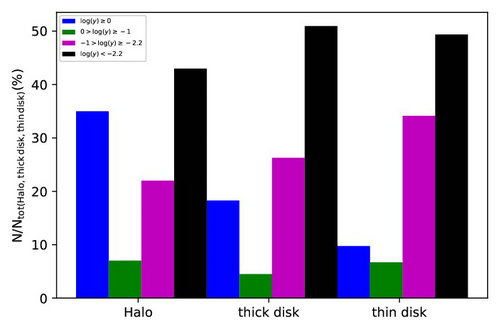Researchers verified the formation theory of hot subdwarf stars with LAMOST DR5
An international team consisted of Yangping Luo of China West Normal University, Peter Nemeth of Astronomical Institute of the Czech Academy of Science, Deng Licai of National Astronomical Observatories of the Chinese Academy of Science, and Zhanwen Han of Yunnan Observatories of the Chinese Academy of Science presented the largest catalogue of the hot subdwarf atmospheric parameters using the LAMOST DR5. Combing with the Gaia DR2, this team presented, for the first time, the fractional distributions of the four hot subdwarf helium groups in the halo, thin disk and thick disk, which are in good agreement with the predication of the formation theory of hot subdwarf stars by Han et al. (2002, MNRAS, 336, 494; 2003, MNRAS, 341, 669; 2008, A&A, 484, L31). This work has been published on The Astrophysical Journal (Volume 881, Number 1) on August 2019.
Hot subdwarf stars are core helium-burning stars of about half a solar mass, covered by a very thin hydrogen envelope. In the Hertzsprung-Russell diagram, they are located between main sequence and white dwarf stars. The optical spectra resemble that of O and B main sequence stars but their typical luminosity is much lower than on the main sequence, also known as the extreme horizontal branch. In general, these stars were traditionally divided into O type subdwarf (sdO) and B type subdwarf (sdB) stars based on their spectra features. Unlike the normal horizontal branch stars, their very thin surface hydrogen envelope cannot allow to pass the AGB and then evolve directly into white dwarfs. Hot subdwarf stars are very interesting and significant objects. They are enriching the research of astrophysics involving in binary evolution, asteroseismology, exoplanet, galaxy evolution, progenitors of Ia supernova in expanded cosmology, gravity wave and play a key role in these researches. For a long time, their formation channel was an unsolved mystery. The question how these stars lose nearly their entire envelope at the RGB before the helium core flashed is still unanswered. Han et al. (2002, MNRAS, 336, 494) put forward three formation channels: stable Roche lobe overflow, common envelope ejection and the merger of double helium white dwarfs. Figure 1 shows the fractional distributions of the four hot subwarf helium groups in the halo, thin disk and thick disk: He-rich hot subdwarf stars with log(y)>0 are from the double helium white dwarf merger, He-deficient hot subdwarf stars with -2.2<log(y)<-1 from the common envelope ejection, and He-deficient hot subdwarf stars with log(y)<-2.2 from the stable Roche lobe overflow channels. In addition, this team finds that the merger of helium white dwarfs with low mass main sequence stars may not be the main formation channels of He-rich hot subdwarf stars with -1<log(y)<0.

Figure. The fractional distributions of the four hot subdwarf helium groups in the halo, thin disk and thick disk.
This paper can be accessed at https://iopscience.iop.org/article/10.3847/1538-4357/ab298d